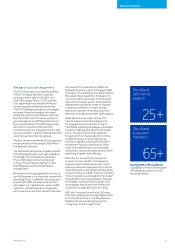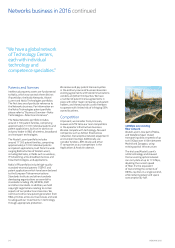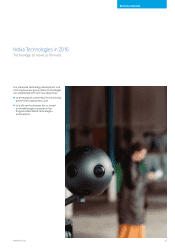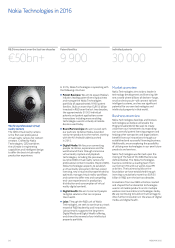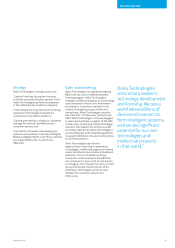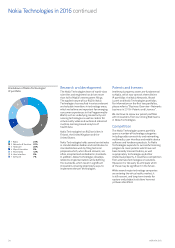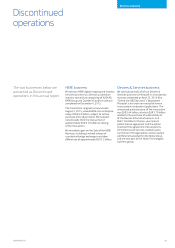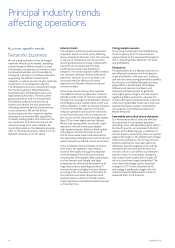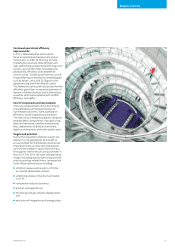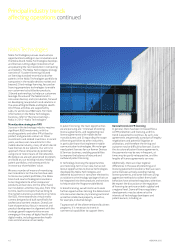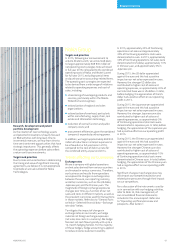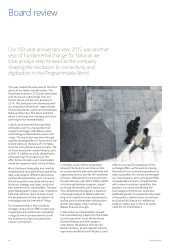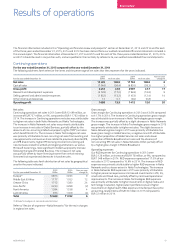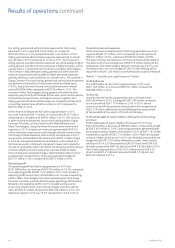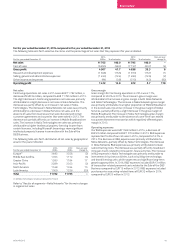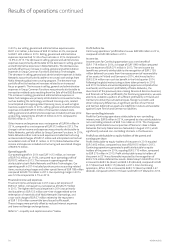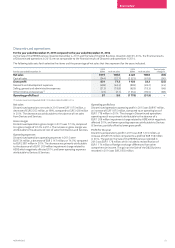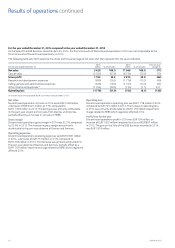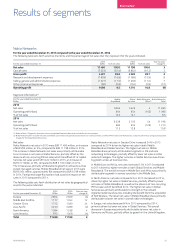Nokia 2015 Annual Report Download - page 45
Download and view the complete annual report
Please find page 45 of the 2015 Nokia annual report below. You can navigate through the pages in the report by either clicking on the pages listed below, or by using the keyword search tool below to find specific information within the annual report.
43NOKIA IN 2015
Business overview
Research, development and patent
portfoliodevelopment
As the creation of new technology assets
andpatented innovations is heavily focused
on R&D activities with long lead-time to
incremental revenues, we may from time to
time see investment opportunities that have
strategic importance. This generally aects
the operating expenses before sales reect
areturn on those investments.
Targets and priorities
Due to risks and uncertainties in determining
the timing and value of signicant licensing
agreements, we believe it is not appropriate
to provide an annual outlook for Nokia
Technologies.
Nokia Group
Targets and priorities
In 2015, following our announcement to
acquire Alcatel Lucent, we announced plans
totarget approximately EUR 900 million of
netoperating cost synergies to be achieved
infullyear 2018, compared to the combined
operating costs of Nokia and Alcatel Lucent
forfull year 2015, excluding special items
andpurchase price accounting-related items.
The operating cost synergies are expected
tobe derived from a wide range of initiatives
related to operating expenses and cost of
sales, including:
■streamlining of overlapping products and
services, particularly within the Mobile
Networks business group;
■rationalization of regional and sales
organizations;
■rationalization of overhead, particularly
within manufacturing, supply chain, real
estate and information technology;
■reduction of central function and public
company costs; and
■procurement efficiencies, given the combined
company’s expanded purchasing power.
In addition, we target approximately EUR 200
million of reductions in interest expenses to
be achieved on a full year basis in 2016,
compared to the cost of debt run rate for
thecombined entity at year end 2014.
Trends aecting our businesses
Exchange rates
We are a company with global operations
andnet sales derived from various countries
and invoiced in various currencies. Therefore,
our business and results from operations
areexposed to changes in exchange rates
between the euro, our reporting currency,
andother currencies, such as the US dollar,
Japanese yen and the Chinese yuan. The
magnitude of foreign exchange exposures
changes over time as a function of our net
sales and costs in dierent markets, as well as
the prevalent currencies used for transactions
in those markets. Refer also to “General Facts
on Nokia—Selected nancial data—Exchange
rate data” below.
To mitigate the impact of changes in
exchange rates on our results, we hedge
material net foreign exchange exposures
(netsales less costs in a currency). We hedge
forecast net cash ows typically with up to a
12-month hedging horizon. For the majority
of these hedges, hedge accounting is applied
to reduce income statement volatility.
In 2015, approximately 30% of Continuing
operations net sales and approximately
30%of Continuing operations costs were
denominated in euro. In 2015, approximately
35% of Continuing operations net sales were
denominated in US dollar, approximately 10%
in Chinese yuan, and approximately 5% in
Japanese yen.
During 2015, the US dollar appreciated
against the euro and this had a positive
impact on our net sales expressed in euros.
However, the stronger US dollar also
contributed to higher cost of sales and
operating expenses, as approximately 30% of
our total cost base was in US dollars. In total,
before hedging, the appreciation of the US
dollar had a positive eect on our operating
prot in 2015.
During 2015, the Japanese yen appreciated
against the euro and this had a positive
impact on our net sales expressed in euros.
However, the stronger Japanese yen also
contributed to higher cost of sales and
operating expenses, as approximately 5%
ofContinuing operations total costs were
denominated in Japanese yen. In total, before
hedging, the appreciation of the Japanese yen
had a positive eect on our operating prot
in2015.
During 2015, the Chinese yuan appreciated
against the euro and this had a positive
impact on our net sales expressed in euros.
However, the stronger Chinese yuan also
contributed to higher cost of sales and
operating expenses, as approximately 10%
ofContinuing operations total costs were
denominated in Chinese yuan. In total, before
hedging, the appreciation of the Chinese yuan
had a negative eect on our operating prot
in 2015.
Signicant changes in exchange rates may
also impact our competitive position and
related price pressures through their impact
on our competitors.
For a discussion of the instruments used by
usin connection with our hedging activities,
refer to Note 35, Risk management, of
ourconsolidated nancial statements
included inthis annual report. Refer also
to“Operating and nancial review and
prospects—Risk factors”.


